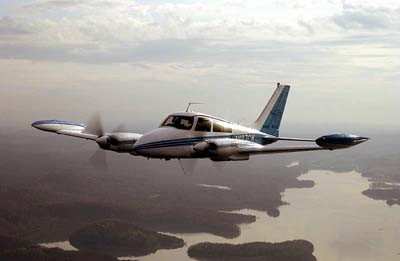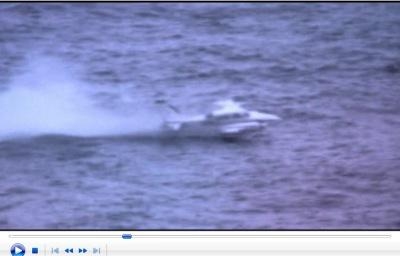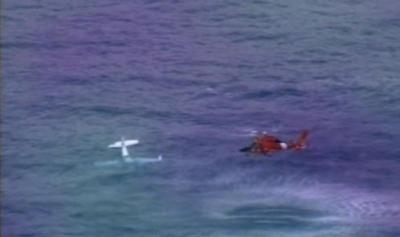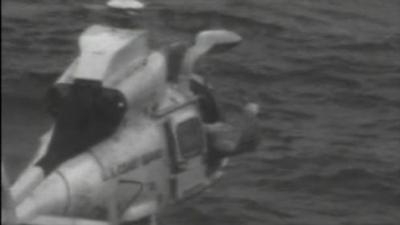Behind-The-Scenes Story Of A Cessna 310 Down En Route To
Hawaii
The Big Island of Hawaii lies in the center of the vast Pacific
Ocean more than 2,500 miles from the nearest point of land. Yet
despite its remoteness, dozens of aircraft of all sizes make the
long flight each day without issue. For one pilot flying from
California in a small twin engine Cessna 310, this was a routine,
well planned flight.
Cessna 310 File Photo

Traveling at an average 175.2 mph, Charles Brian Mellor's flight
plan would have him reach the picturesque black beaches of Hilo
just shy of 13 hours. During the flight, he had ample time to check
and recheck his calculations. In doing so he came to a disturbing
conclusion. He would not have the opportunity to fly into paradise.
He was going to run out of fuel long before reaching the islands.
At 12:30 p.m. the command duty officer, at the 14th Coast Guard
District Joint Rescue Coordination Center, answers the phone and
receives a briefing of Mellor's situation from the Federal Aviation
Administration in Honolulu. Lt. Bridget Fitzgibbons learns that
Mellor, a 65-year-old man is flying his Cessna from Monetary,
Calif. to Hilo, Hawaii, and is running out of fuel about 500 miles
from land.
Fitzgibbons calls FAA Oakland for flight details that will help
her make accurate decisions in planning Mellor's rescue.
When Mellor made his flight plan in Monterey he determined how
much fuel he would need to travel to Hawaii. The Cessna's
internal fuel tanks do not allow for trans-ocean flights, so he was
allowed extra internal fuel bladders to complete the transit.
Mellor stripped out the back seats of the aircraft and replaced
them with the extra fuel tanks required to make the trip. Although
tailwinds pushed Mellor and his plane 60 percent of the way, he
encountered headwinds after crossing the point of no return. It was
at this point his calculations indicated something was wrong. He
had enough fuel for 14 hours but had been airborne for 13 of what
should have been a 12 hour flight.
Meanwhile, Fitzgibbons reaches out to Richard Roberts, District
14 response management deputy branch chief, to explain the
impending rescue. Roberts, a former Coast Guard pilot, has vital
experience and knowledge to contribute to the rescue. Although
rescue of Mellor was imminent, he must first survive ditching his
aircraft somewhere in the Pacific. Roberts and Fitzgibbons begin to
formulate a plan. "The very first thing that needed to happen was
to ensure all response coordination efforts are being managed to
the fullest capacity," said Roberts. "Phone calls were made to not
only to Air Station Barbers Point, but U.S. Pacific Command, the
Navy, the nearest hospital and then to Coast Guard Pacific Area
Command Center in California and Coast Guard Headquarters."
Coast Guard Video Capture

The plan was to have a Coast Guard Air Station Barber's Point
HC-130 Hercules airplane aircrew rendezvous with Mellor. The
aircrew would coach Mellor through the complex process for ditching
the Cessna. At Air Station Barbers Point, Hercules aircraft
commander Lt. Eric Majeska gathers the aircrew to determine the
best course of action. Majeska noted that the challenge facing them
would test each crewmember's ability to function in a high stress
situation. As the aircraft commander, Majeska explained "everything
is depending on your ability to remain calm and confident to help
someone who is going to have to make decisions that will determine
their own fate."
For the aircrew, the confidence to help Mellor would come from
their training and experience. Majeska and his co-pilot, Lt. j.g.
Bryan Weber, reached out to other seasoned pilots to tap into
decades of flying experience. For Webber, a junior officer
and pilot, gaining the knowledge of others was crucial for
developing the best course of action. "His ability to ditch this
plane successfully would depend on all the knowledge we would be
able to lend him," said Weber.
Once Mellor entered the water there would be little the Hercules
aircrew could do. That is when the MH-65 Dolphin helicopter crew
takes over the rescue plan. They would meet the Cessna 310 at sea
and deploy a rescue swimmer to recover Mellor after the plane
ditched. As both aircrews prepared to launch, Fitzgibbons was busy
developing the check list for the rescue plan. In gathering
information, Fitzgibbons realized that Mellor may have to ditch
outside the 80 mile range of the helicopter. If this occurred, a
backup plan would be necessary to rescue Mellor. Fitzgibbons made a
call to the commanding officer of the Coast Guard Cutter Kiska, a
110-foot patrol boat stationed in Hilo. He was directed to get the
cutter ready and underway within the hour. "Our biggest fear at
this time was Mellor may have to ditch his aircraft approximately
100 miles off the Big Island," said Petty Officer 1st Class Chris
Sena, a watchstander working with Fitzgibbons. Dolphin
helicopters only have an approximate range of 80 miles. For this
reason the Kiska and crew might become necessary.
Coast Guard Image

As the rescue crews were preparing, Mellor's plane caught a
small tailwind and was covering more ocean than previously
anticipated. Sena and Fitzgibbons coordinated a track line with the
cutter to ensure they would intercept the Cessna. By this time the
Hercules aircrew launched, and headed northwest to rendezvous with
Mellor. As the multiple Coast Guard assets took to the ocean, and
air or stood by the radio, all the elements of the rescue began to
come together like a well-oiled machine. All with one goal; get to
Cessna and rescue Mellur.
More than 150 miles off shore from Hawaii, the Hercules crew
rendezvous with Mellor. By this time the Dolphin helicopter crew
had landed at the Hilo International Airport for fuel and waited
for their call to launch. The Hercules crew established
communications with Mellor and the pilots began to talk him through
the ditching sequence and rescue. "As soon as we found him on a
frequency, we introduced ourselves and told him we are the Coast
Guard and we are here to help him get through this," said Petty
Officer 2nd Class Miguel Martinez, the radio man with the Hercules
crew. "Immediately he seemed relieved and we switched to a
radio frequency with less traffic."
The aircrew instructed Mellor to secure anything that was loose
in his aircraft and began to review his two options for ditching
the plane. Mellor's options would be a power-on ditch or a
power-off ditch. During a power-on ditch Mellor would have full
control of the plane's engine, Webber explained. This allows
the pilot to add power and make the airplane more stable or add
power to gain altitude to go up and then back down. A power-off
ditch is where the engine is already gone, whether it was secured
by the pilot or not. In this situation, Mellor would have
only one shot at landing the plane in the water. "Mellor originally
wanted to perform a power-off ditch," said Weber. "However, we
stood by our advice and said it would be best to conduct a power-on
ditch."
Coast Goard Image

The reasoning behind the power-on recommendation lies in the
Cessna's twin engine design according to Webber. It would be very
unlikely for both the engines to cut off at the same time during a
power-off ditch. This would make the plane very unstable and
Mellor would be forced to disable both engines manually, adding
another task to the already complex situation. As Mellor debated
which ditch to perform, the cutter Kiska and crew staged
approximately 40 miles northeast of the Big Island. The Dolphin
helicopter crew finished re-fueling and stood by for notification
that Mellor was within range.
Sector Honolulu watch standers instructed the Dolphin rescue
crew to launch as Mellor crossed the 80-mile mark. With the
guidance of air traffic control personnel, the helicopter crew also
rendezvoused with Mellor. At this point the the command center
watchstanders could only listening to the radio traffic and wait
for the air crews to execute the next phase of the mission. From
this point on it was up to Mellor to follow the instructions given
by the Coast Guard aircrew and ditch his aircraft into the rolling
seas off of Hawaii.
13 miles from the Big Island the Hercules dropped to 1,000 feet
and the Dolphin helicopter crew came in behind Mellor and tailed
him as he descended into the South Pacific Ocean. "Looking out, at
first I was sure he had it, he was going to be fine and we're just
out here for protocol," said Petty Officer 3rd Class Jeffery
Moeschler, flight mechanic aboard the Dolphin helicopter. "But as
I'm watching him drop down to 400 feet and lower, he just kept
dropping. I just think it isn't going to happen."

In the front of the dolphin, aircraft commander Lt. Matthew
Matsuoka, watched as the Cessna glided above the water. He calls
for "rescue check two" and Moeschler and the rescue swimmer prepare
for the impending rescue. They watch as Mellor glided his Cessna
along the tops of the rolling seas, kicking up spray as the plane
made several light brushes before dropping the nose and skidding
across the surface as the Cessna spun 180 degrees in froth of
turbid water before coming to a stop. Mellor kept the plane
vertical, but within moments it begins to sink. The Dolphin crew
approached as Mellor crawled out of the Cessna and onto the wing,
clutching a life raft. Within seconds, the rescue swimmer, Petty
Officer 2nd Class James Clyne, was lowered to the water. He swam to
Mellor and guided him off the wing. Together, they swam to
the rescue basket. Mellor was safely placed in a rescue
basket and hoisted into the helicopter by Moeschler. Moments later
the Cessna slipped beneath the surface and sank in more than 6,000
feet of water.
Mellor was taken to Hilo Medical Center in good condition with
no visible injuries. In the command center Fitzgibbons made final
notes in the official operational summary report which was filled
with a complex web of agency interaction, information sharing and
asset coordination which led to the successful rescue. But the
final piece of information recorded was perhaps the simplest and
most important. One life saved.
ANN Salutes Petty Officer 3rd Class Angela
Henderson
 Aero-News: Quote of the Day (10.24.25)
Aero-News: Quote of the Day (10.24.25) ANN's Daily Aero-Linx (10.24.25)
ANN's Daily Aero-Linx (10.24.25) NTSB Final Report: Cirrus SR22
NTSB Final Report: Cirrus SR22 Airborne-Flight Training 10.23.25: PanAm Back?, Spirit Cuts, Affordable Expo
Airborne-Flight Training 10.23.25: PanAm Back?, Spirit Cuts, Affordable Expo Airborne 10.22.25: Rez Takes Plane, DJI v US Drone Ban, HK 747 Cargo Accident
Airborne 10.22.25: Rez Takes Plane, DJI v US Drone Ban, HK 747 Cargo Accident







